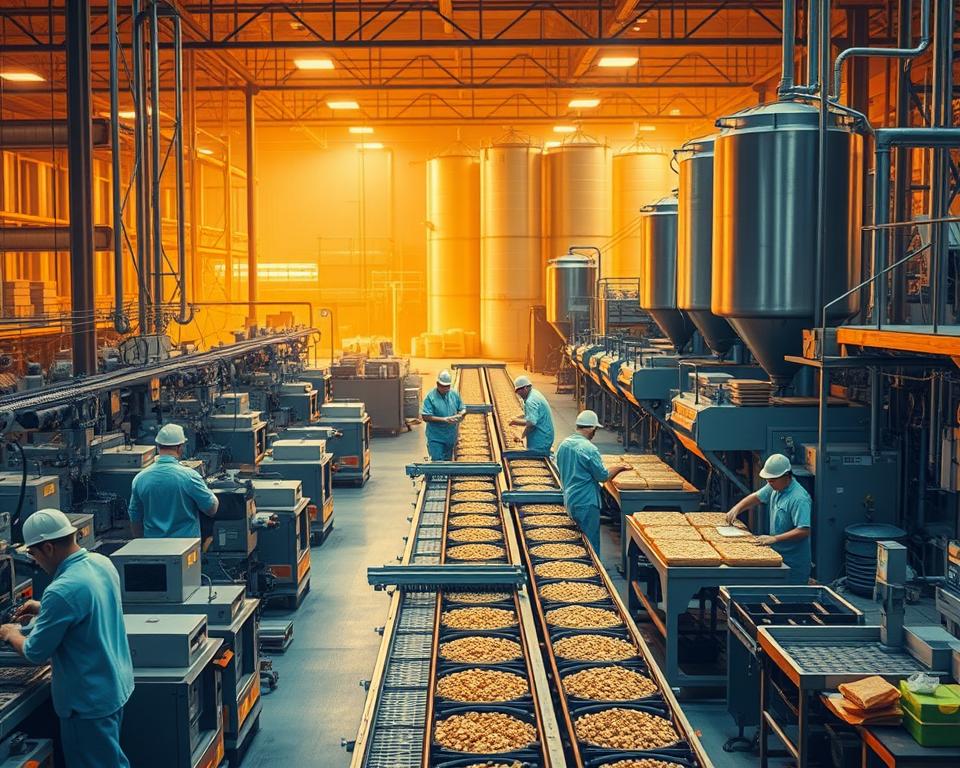Анунсиос
how to Foodtech—you want practical steps that help avoid common mistakes and build stronger products and operations.
Food technology blends food, data, and operations to solve real problems in the food industry. It spans precision agriculture, smart packaging, processing advances, robotics, and digital quality checks. Global momentum is clear: a projected 9.9% CAGR through 2030 means rapid change and rising stakes for safety and brand trust.
This guide helps founders, product teams, and operators who aim to scale responsibly. You will see how to define the field, pressure-test strategy, design for safety and traceability, and right-size technology for production. Expect hands-on examples from vertical farming, plant-based processing, smart packaging, and AI-assisted quality checks.
What matters most: ethics, compliance, and measurable outcomes like quality, safety, adoption, and cost. Read on with confidence—rigor and discipline can make your next iteration faster, safer, and more resilient.
Introduction: how to Foodtech without tripping on the basics
You can avoid common setup mistakes and build safer, scalable products by learning a few practical basics first.
Анунсиос
Why this matters now: Consumer demand for convenience, sustainability, and trusted safety is reshaping the food industry. Global investment and fast-paced innovation mean new products and regulations arrive quickly. India’s food processing projection (IBEF) shows the scale of opportunity and disruption.
Scope is broad. It spans precision agriculture and vertical farms, processing lines and smart packaging, last-mile delivery, and connected kitchens. AI and data are improving inspection and quality checks, yet strong processes remain the backbone of reliable outcomes.
What you should focus on next: differentiate foundational research from applied work—food science and engineering set the rules, applied technology implements them. Practical skills, pilot testing, and labeled compliance matter more than flashy tools.
Анунсиос
- Start small: pilot, measure, iterate with real user and technician experience.
- Prioritize labeling accuracy and regulatory checks when digitizing operations.
- Explore career paths: lab roles, operations, product teams, or become food technologist through hands-on learning.
Keep reading for clear definitions so your team uses the same language during planning and builds with confidence.
Defining the field clearly: FoodTech vs. food science vs. food engineering
Clear definitions stop confusion when teams mix research, equipment design, and applied innovation. Use plain labels so your team picks the right method at each stage.
FoodTech as applied innovation across the food system
Food technology connects agriculture, processing, logistics, retail, and kitchens with digital and mechanical tools. It focuses on efficiency and sustainability and guides choices from farm data to final delivery.
Food science as the foundational research layer
Food science studies composition, chemistry, and biology. These insights explain why ingredients behave a certain way during mixing, heating, or fermentation. Solid research validates claims and informs safe processing.
Food engineering as scale-up, equipment, and process design
Food engineering designs line layouts, heat and mass transfer steps, and control strategies that produce consistent output. Techniques like extrusion or fermentation create plant-based meat textures in the lab, then engineering makes them manufacturable at scale.
- Example: extrusion + science creates texture; engineering scales the line and sets controls.
- AI vision systems help inspection, but validation comes from scientific testing and process controls.
- A food technologist translates research into manufacturable specs and documents terms so vendors and plants match expectations.
Next step: document definitions early so your cross-functional team, vendors, and plant staff interpret specs the same way before you scale production.
Strategy mistake: chasing trends without product-market-regulatory fit
Before scaling, prove that kitchens, plants, and buyers will adopt and pay for your idea.
Validate need first. Start with a clear problem statement. Interview chefs, QA leaders, buyers, and operators. Use short discovery interviews to confirm the real pain point and typical workflows.
Test willingness and feasibility. Run quick pilots in real kitchens or small plants. Measure cook performance, texture for plant-based concepts, and allergen risks during these trials.
- Model energy and yield for vertical farms; check distribution costs for your market.
- Confirm smart appliance fit with existing workflows, training time, and maintenance needs.
- Build a minimal viable specification (MVS) with quality attributes, shelf life, and critical control points.
Map regulatory paths early. Classify your product for safety and labeling and consult government guidance or food safety consultants. Avoid language that implies medical benefits.
Stage pilots with go/no-go gates. Tie decisions to adoption, cost-to-serve, and compliance milestones. A small, well-adopted product often outperforms a flashy, unscalable launch.
Data and safety mistake: weak traceability and QA
Weak data flows make it hard to act fast when a safety issue appears.
Build end-to-end visibility from supplier lots through finished food products and distribution. Map lot-level traceability and assign owners for each handoff. Use clear identifiers so records match physical pallets during audits.
Build end-to-end visibility with sensors, IoT, and blockchain
Use IoT sensors for cold-chain monitoring and set alerts for temperature or humidity excursions. Consider immutable logs like blockchain for high-risk categories. These tools speed audits and speed recalls when you need action.
Design for allergen control, labeling accuracy, and recalls
Standardize allergen controls: dedicate lines or use validated cleaning and verified label changes. Keep a positive release process and document sampling plans. Create a recall playbook with roles, contact trees, and regular drills so you can act within hours.
Real-world cue: AI-assisted quality control to reduce defects
Deploy AI vision systems to catch foreign matter, fill errors, and mislabels. Verify performance with controlled trials and measure false positives. Train teams to log deviations in a shared system and track near-misses as leading indicators.
- Document specs, acceptance criteria, and sampling plans so technologists and operators align.
- Monitor storage and processing metrics to cut food waste and protect quality.
- Communicate transparently with customers when issues arise; clear steps keep people food safe and protect trust.
Supply chain mistake: ignoring waste, storage, and shelf-life science
Small storage errors at the farm or plant can cascade into major food loss down the line.
Fix the basics first: audit where loss happens—farm, receiving, storage, processing, packing, or last-mile delivery. Map those touchpoints and assign owners so near-miss data becomes usable.
Leverage smart packaging and temperature monitoring
Use smart packaging with freshness or time-temperature indicators for perishable products. These tags cut food waste by giving visible cues for action.
Combine packaging with continuous IoT monitoring in transport and cold rooms. Set alerts and a response SOP so teams can fix excursions fast.
For evidence-based controls, link your monitoring strategy with a cold-chain monitoring study or similar research.
Align inventory with analytics to cut overstock and spoilage
Model demand with analytics and apply FEFO in your WMS. Segment shelf-life by route and season instead of relying on averages.
- Optimize packaging atmospheres and handling for produce and plant-based items to reduce bruising and dehydration.
- Share quality and temperature data with suppliers so upstream practices on the farm improve.
- Partner with surplus redistribution platforms and track waste types weekly to fix root causes and measure savings.
Technology mistake: over-automating or under-investing in R&D
Choose automation that solves a clear labor or safety gap before expanding across lines. Too much automation creates brittle systems. Too little research leaves product problems hidden.
Right-size robotics by targeting repeatable, high-risk, or ergonomically tough tasks. Use machines for cutting, sorting, and packaging. Keep people for judgment, hospitality, and adjustments.
Iterate with pilot lines and trials
Run a single robotic cell before scaling. Measure uptime, yield, sanitation time, and failure modes. Use short runs for extrusion and fermentation when developing plant protein textures that mimic meat.
Experiment then validate
Try 3D printing for novel structure exploration. Then test manufacturability on conventional equipment. Involve operators and a food technologist early. They spot cleaning and safety issues fast.
- Automate repeatable tasks; keep humans for judgement.
- Pilot robotics locally and track key metrics.
- Budget annual research for trials, analytics, and consumer testing.
Capture learnings centrally and tie R&D milestones to clear problem statements: waste cut, safety gains, or cost per unit. That balance keeps innovation practical and resilient.
Operations mistake: scaling before process control is stable
Stable controls at each step make production reliable when you move from bench trials to full runs. Rushing scale-up often uncovers hazards that cost time and trust. Follow a clear stage-gate path and validate critical limits before larger runs.
- Lab → pilot → limited market → full-scale, with pass/fail criteria at each gate.
- Define control limits for critical steps and validate them before scaling processing steps.
- Pilot with production teams present; collect operator feedback and refine SOPs.
Document HACCP, preventive controls, and validation:
- Keep flow diagrams, hazard analyses, and critical limits in a single file for audits.
- Train teams on changeover, sanitation, and sampling so procedures stay consistent across plants.
- Use SPC charts to catch drift, run pre-shipment checks for label accuracy and lot traceability, and qualify second sources.
Practical habit: run a post-mortem after each run and involve engineering early so utilities and ventilation match the process. These steps protect quality, safety, and steady production as you scale.
Talent and partnerships mistake: building in isolation
Working alone raises risk. You need a mix of lab, plant, and data talent plus external partners. This reduces surprises and speeds reliable launches.
Blend scientists, engineers, and data talent
Build core squads that pair food scientists, engineers, data analysts, and operations leads. That mix helps you balance safety, throughput, and product quality.
Clarify roles so technologists and operators share ownership of checks and outcomes. Invest in cross-training and short rotations as part of career paths.
Partner across farms, processors, and marketplaces
Work with farms for consistent ingredient specs and share data that improves upstream quality. Use co-manufacturers for capacity and rapid validation while marketplaces test demand.
- Map roles so a food technologist can rotate through QA, product, and process engineering.
- Set shared KPIs with partners: waste saved, quality scores, and on-time delivery.
- Run supplier demos, tech talks, and short shadowing stints to grow practical experience.
How to Foodtech: a practical playbook to avoid common pitfalls
Begin by naming the exact operational gap you plan to close and the metric you will track. This keeps product development focused and measurable from day one.
Start with the problem: define whether you target efficiency, sustainability, or safety. Set a numeric goal—cut waste by X%, lower unit cost by Y, or reduce safety holds by Z.

Prototype fast and test in real settings
Prototype on benchtop gear, then run short pilots in kitchens or small plants. Use extrusion and fermentation trials for texture work and pilot lines for throughput checks.
Measure what matters
Track safety deviations, quality scores, yield, and staff adoption. Use AI vision for defect checks and IoT logging for environmental data.
Plan compliance and traceability from day one
Create a lightweight compliance plan that covers labeling, allergen control, and lot traceability. Consider blockchain for immutable records when risk is high.
- Define the target metric and owner.
- Prototype, document variables, and reproduce wins.
- Test in real kitchens/plants; log deviations.
- Choose minimal viable tech before full automation.
- Run biweekly cross-functional reviews and update specs.
Close the loop with suppliers and partners so inputs improve with your validated data. This keeps product quality, production, and food safety aligned as you scale.
Заключение
End with practical checkpoints that align research, engineering, and line teams. Use small pilots and clear metrics so experiments become reliable production steps.
Validate product-market-regulatory fit early, document labeling and traceability, and keep safety front and center. Pair science with engineering and operations before scaling.
Partner across agriculture, processors, marketplaces, government, and companies. Share learnings and support your food technologist and technologist teams.
Refresh your research and compliance notes each quarter. The food technology industry moves fast—start with one measurable improvement this week and build on that win.



